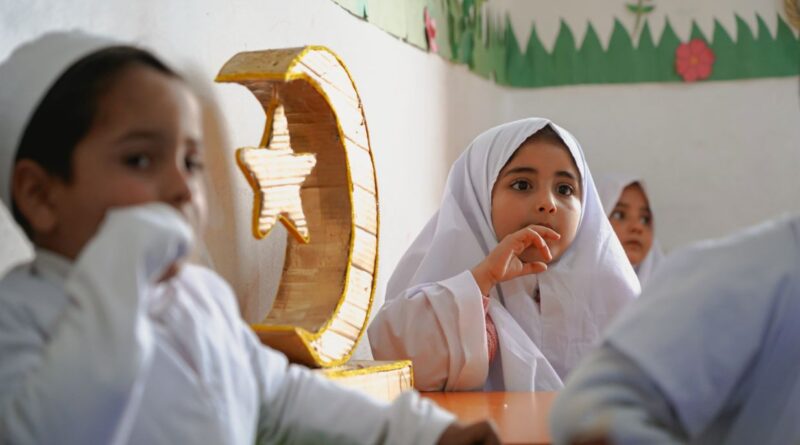A Sunnah Storytime: Hadith Stories for Little Ones
One of the most effective ways to introduce young children to Islam is through the Sunnah. The vast collections of hadith literature offer an almost endless supply of stories rich with wisdom, morals, and inspiration. These stories not only provide valuable lessons but also nurture a deep love for the Prophet Muhammad (peace and blessings be upon him) and his companions. This does not mean that parents must open a heavy volume from the Sahih sittah to read at bedtime. On the contrary, oral storytelling can be just as impactful, perhaps even more so. It connects us to our Islamic heritage and the oral traditions of early Muslims. By familiarizing themselves with a hadith, parents can recount it to their child in their own words, adding engaging details and emotion as if reading from a colorful picture book.
As children, many of us grew up with nursery rhymes, the ABCs, and timeless fairy tales that formed a key part of our early education. For Muslim families, it is essential that the Qur’an and Sunnah also take center stage in a child’s learning and development. Research shows that when parents use rich and engaging language during storytelling, it strengthens children’s language and literacy skills well into elementary school1. When we combine that with meaningful Islamic content, such as stories from the Sunnah, we give our children the best of both worlds: a solid foundation for academic success and a deeper connection to their faith. Storytelling becomes a powerful tool to nurture their minds and their hearts.
Storytelling offers a meaningful way to incorporate Islamic teachings in a manner that is age-appropriate, memorable, and enjoyable. When parents share a hadith through storytelling, they are not only teaching their child about Islam; they are helping to revive a Sunnah. It becomes a form of Islamic education within the home and an opportunity to build family bonds around faith. The Prophet Muhammad, peace and blessings be upon him, said:
“Convey from me, even if it is one verse.”
(Sahih al-bukhari, 3461)
Even short hadith can spark meaningful conversations, inspire good behavior, and become a beloved part of bedtime routines. Hadith story time has the potential to shape knowledge, character, and identity by planting seeds of love for Allah, His Messenger, and this beautiful way of life.
The following are some of my personal favorites, along with age-appropriate lessons that can be drawn from them and shared during story time:
- The Slander of Aisha (may Allah be pleased with her)
When false rumors were spread about Aisha, both she and the Prophet Muhammad, peace and blessings be upon him, remained patient. Eventually, her innocence was revealed by divine revelation. This powerful story can help young children understand why we should never jump to conclusions, spread gossip, or speak badly about others. It lays the foundation for empathy, respect, and honesty. (Sahih al-Bukhari 4750)
- The Story of Kaʿb ibn Malik (may Allah be pleased with him)
Kaʿb delayed joining the Battle of Tabuk for no real reason, and later deeply regretted his procrastination. Thankfully, Allah accepted his sincere repentance. This story teaches children the importance of acting promptly, avoiding excuses, and being honest about their mistakes. (Sahih Muslim, 2769)
- The Friendly Competition Between Umar and Abu Bakr (may Allah be pleased with them)
In one memorable moment, Umar ibn Al-Khattab tried to outdo Abu Bakr As-Siddiq in charity, only to discover that Abu Bakr had already donated everything he owned! This tale encourages children to strive to do good, not to boast, but to grow closer to Allah and be generous with their wealth and time. (Sunan al-Tirmidhi, 3675)
- The Journey of Salman al-Farsi (may Allah be pleased with him)
Salman searched for the truth across many lands and faiths until he found Islam. This story offers an inspiring way to teach children about the beauty of spiritual seeking and the importance of showing kindness, admiration, and respect to those who have converted to Islam after facing many difficulties. (Sahih Bukhari, 3946)
- The Perseverance of Bilal ibn Rabah (may Allah be pleased with him)
Despite enduring severe torture for accepting Islam, Bilal remained firm in his faith, repeatedly declaring “Ahad, Ahad” (One, One). His bravery teaches children the importance of standing firm for what is right, even when it is difficult, and helps instill a sense of pride in their faith. (Sunan Ibn Majah, 150)
Each of these hadith-based stories can be told in a manner that is simple and engaging, using language that is suitable for your child’s age. It is not necessary to be a scholar or professional storyteller, just a loving guide using the treasures of our tradition. When telling stories, be naturally expressive and enthusiastic. Use gestures, facial expressions, and sound effects to help bring the story to life. Even simple visuals, like drawing on a whiteboard or using props from around the house, can enhance your child’s focus and imagination. I personally love using puppets, stuffed animals, and even Legos.
Throughout the storytelling process, engage your child by making it interactive. Ask questions before and after the story to promote reflection and critical thinking. What would they have done in that situation? What was their favorite part? These questions help deepen their connection to the story and the values within it. One of the most meaningful ways to reinforce a hadith story is by asking your child to retell it in their own words. This practice enhances comprehension and aligns with our Islamic tradition of preserving hadith through careful narration. It can be an excellent way to introduce the idea of the chain of narration and the beauty of hadith sciences in an age-appropriate way.
As parents, we know that the lessons found in the Sunnah are far more than bedtime tales. They are timeless gems of guidance for every part of life. For our children, however, these stories can open the door to a world of wonder that will shape their faith foundation while feeding their imagination. When we patiently weave hadith stories into their everyday lives, we are not just teaching; we are building their character and creating a lasting bond with the Prophet Muhammad, peace and blessings be upon him. In doing so, we honor his legacy and walk in the footsteps of the pious generations who came before us.
- Carr, R., & Duke University Center for Child and Family Policy. (2023). The Power of Storytelling: How Parents and Caregivers Can Give Children a Strong Foundation for Language and Literacy Development. Developmental Psychology. Retrieved from https://childandfamilypolicy.duke.edu/news/the-power-of-storytelling-how-parents-and-caregivers-can-give-children-a-strong-foundation-for-language-and-literacy-development/
Bio: Wendy Díaz is a Puerto Rican Muslim writer, award-winning poet, translator, and mother of six (ages ranging from toddler to teen). She co-founded Hablamos Islam, a non-profit organization that produces educational resources about Islam in Spanish (hablamosislam.org). She has written, illustrated, and published over a dozen children’s books and lives with her family in Maryland. Follow Wendy Díaz on social media @authorwendydiaz and @hablamosislam.




